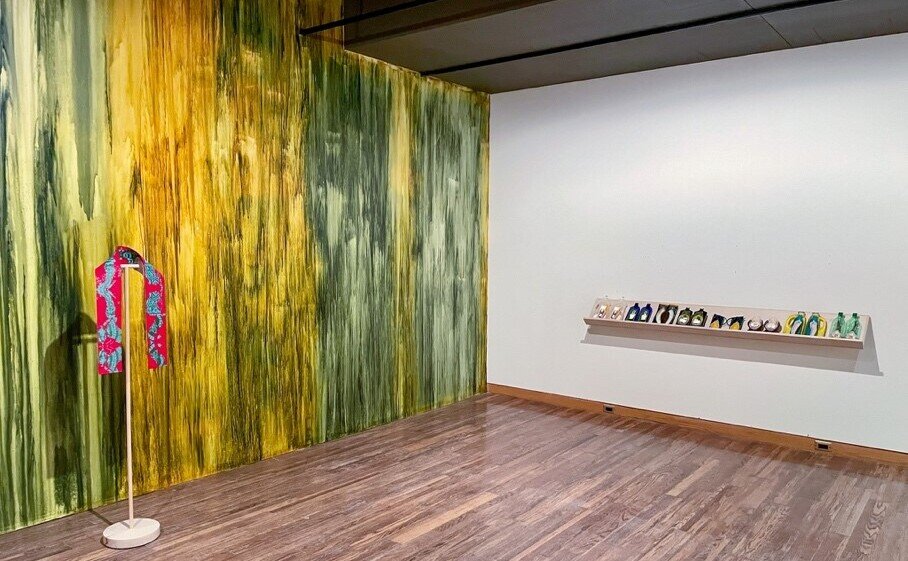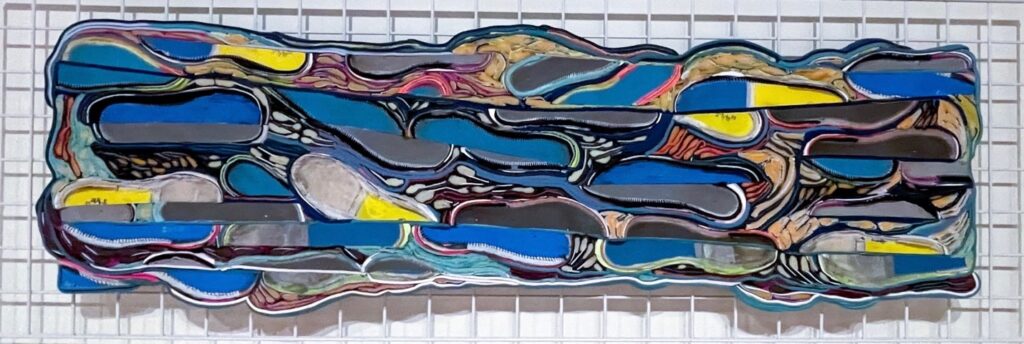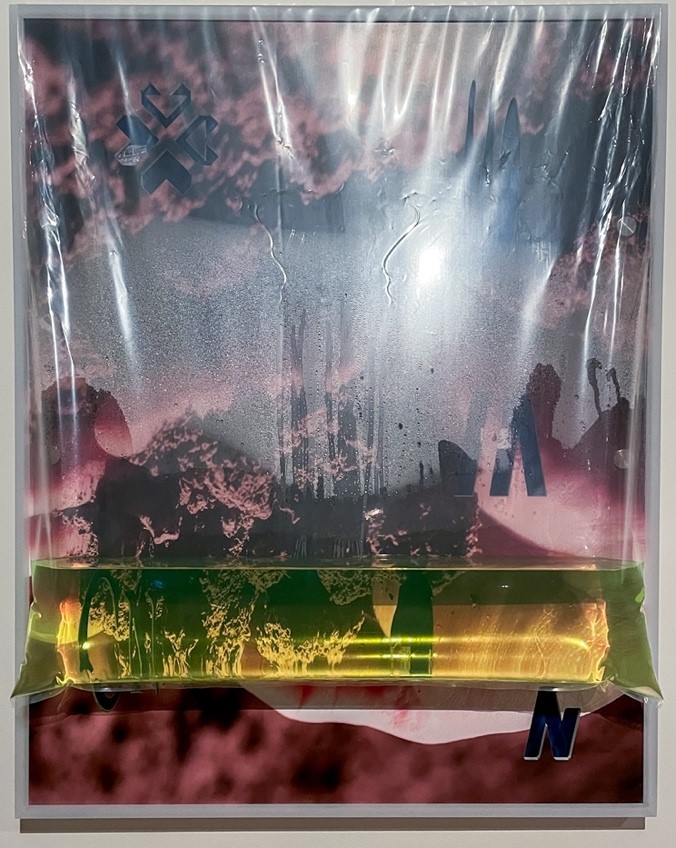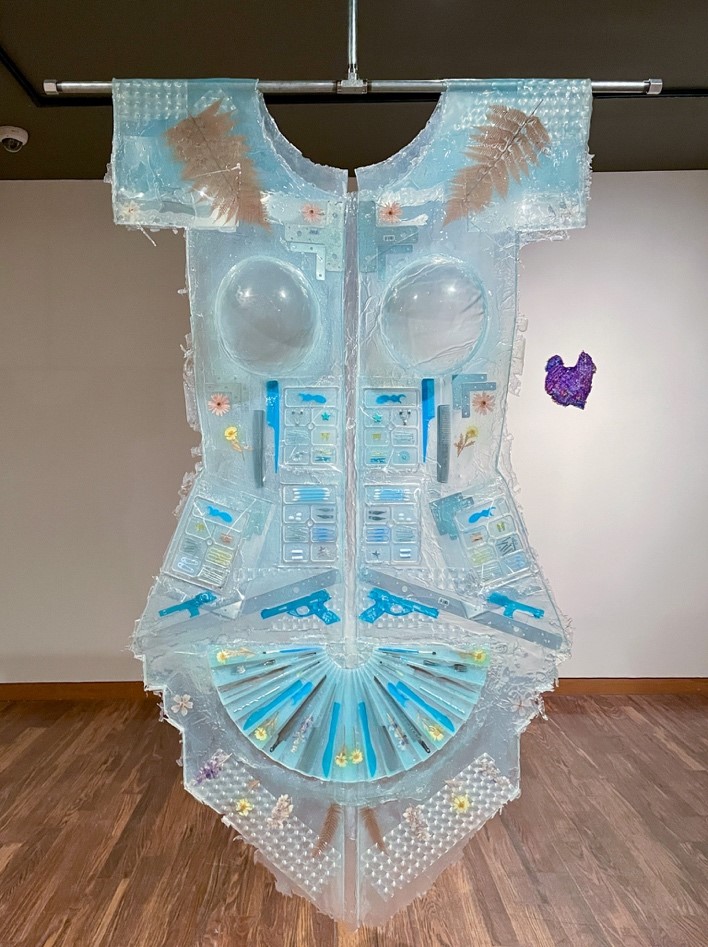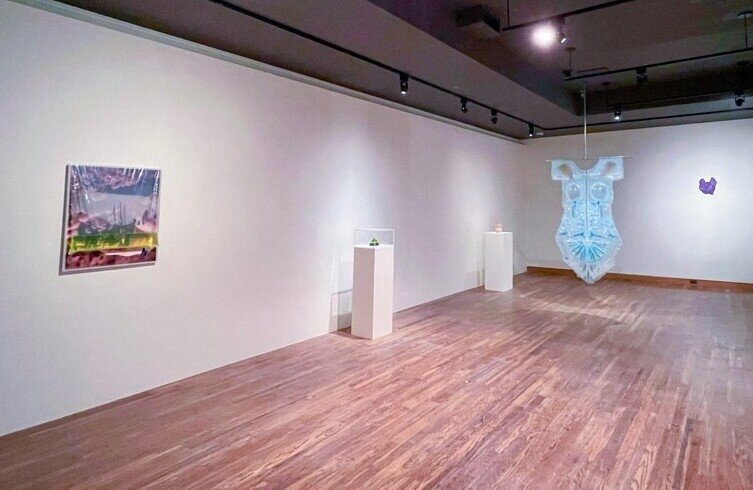Plastic heart: Surface All the Way Through at Art Museum at the University of Toronto
As the name would suggest, Plastic Heart is an experimental exhibition that features plastic at its heart. What comes to mind when you hear the word plastic? Plastic is a lasting material and takes an unknown amount of time to decompose, but it can easily break into smaller pieces and exists as microplastic. It is therefore often considered as immortal. We use plastic as art material; we manufacture plastic into all kinds of products; and we wear plastic every single day. It is undeniably inseparable from our daily experience “with its beauty and toxicity, its helpfulness and ubiquity.”
Installation view of Plastic Heart: Surface All the Way Through at Art Museum at the University of Toronto, 2021
The exhibition features the works of the Synthetic Collective which has recently done a study of microplastics pollution on 67 beaches around the Great Lakes. The research is displayed using data visualizations as well as art creations done by members of the Synthetic Collective. In addition, the exhibition has both historical and contemporary artworks relating to plastic as an effort to demonstrate the history of plastic in art and how plastic has challenged museums’ conventions.
The first thing you see in the exhibition is a row of plastic bottles split in half with fruits inside. Lan Tuazon has been collecting plastic containers and objects which she then made into open nested containers that act like an archive, the “future fossils” that represent our consumer culture. False Fruits is a series of sculptures that resemble fruits, and they are laid out like open books and remind us of the blurring boundary between food and plastic.
Lan Tuazon, False Fruits, 2020, found nested containers
Meghan Price’s artwork, New Balance, is made of layers of old running shoes surrounded by striated forms. This illustrates how synthetic products and plastic landfill have become part of the Earth’s upper crust. It is a visual alert that human-made synthetic waste has entered the rock record. The wire frame is usually used for product display, and it is used here to identify people’s consumer behaviors as one of the causes.
Meghan Price, New Balance, 2020, used athletic shoes, painted steel grid
Relating the environmental discussion to museums, have you thought about the environmental impact of an exhibition? In one corner of the room sits several trash bags filled with water bottles, tapes, and other plastic miscellaneous. These are the plastic waste produced while preparing for and installing the artworks. It is interesting to include them as part of the exhibition as viewers are normally unaware of the works behind the scenes. It asks us to think about the possibility of curating a zero-carbon exhibition.
Catherine Telford-Keogh’s work has a very long and descriptive title that can potentially give you some clues for interpretation. It describes a fantasy life of Hal where everything is consumable and in easy reach. The yellow liquid in the plastic bag reminds me of decayed liquid food or polluted water. And the plastic bag here acts like a hygienic barrier but also a breeding ground for bacteria and germs. The sculpture is about the complex interactions that “blend distinctions between chemical, consumable, and contaminated identities.”
Catherine Telford-Keogh, the democratic model of upward mobility saturated his fantasies of the good life, where Hal could languish in bed for years at the Holiday Inn watching National Geographic on piles of damp laundry and money, 2017, Mr.Clean Multi-Surface Antibacterial Cleaner with Summer Citrus, Honey-Can-Do Vacuum Space Bag, Digital Print on Vinyl, Plexiglas
In the same room, Amy Brener’s Flexi-Shield immediately caught my eye. If you look closely, there are combs, cotton swabs, paper clips, pins, etc. inside it, all sealed in this shield like insects trapped in resin. The objects are frozen in time, evoking the questions of preservation of plastic in museums. Speaking of which, many of the historical artworks made in the 1960s and 1970s displayed at the exhibition, such as IAIN BAXTER’s Bagged Place, are starting to degrade. The constant tension between humans’ desire for preservation and immortality and the ever-changing reality is seen throughout the exhibition.
Amy Brener, Flexi-Shield (Empress), 2018, Platinum silicone, pigment, larkspur and chrysanthemum, flowers, fern leaves, miscellaneous objects.
Overall, this exhibition is intriguing and aesthetically appealing in that it investigates plastic as an art material, a result of cultural production, and an artifact that is intertwined with human body. It not only raises important environmental concerns and considers our relationship with plastic but also questions the future of art and exhibition making.
Installation view of Plastic Heart: Surface All the Way Through at Art Museum at the University of Toronto, 2021
Zhiyi Fang
Images are courtesy of Art Museum at the University of Toronto
*Exhibition information: Plastic Heart: Surface All the Way Through, September 8 – November 20, 2021, University of Toronto Art Centre, 15 King’s College Circle, Toronto. Gallery hours: Mon & Thu – Sat 12 – 5 pm, Tue 12 – 8 pm.

